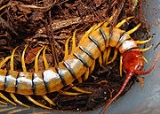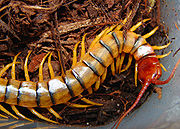
Uniramia
Encyclopedia

Arthropod
An arthropod is an invertebrate animal having an exoskeleton , a segmented body, and jointed appendages. Arthropods are members of the phylum Arthropoda , and include the insects, arachnids, crustaceans, and others...
s. In the past this group included the Onychophora, which are now considered a separate category. The group is currently used in a narrower sense.
.jpg)
Sidnie Manton
Sidnie Milana Manton, FRS was a British entomologist.-Early life:Sidnie Milana Manton was born in Kensington, London the daughter of a dentist. Her sister was Irene Manton , a botanist, She was educated in Kensington and at St...
. This classification divided arthropods into a three-phyla polyphyletic
Polyphyly
A polyphyletic group is one whose members' last common ancestor is not a member of the group.For example, the group consisting of warm-blooded animals is polyphyletic, because it contains both mammals and birds, but the most recent common ancestor of mammals and birds was cold-blooded...
group, with phylum Uniramia including the Hexapoda
Hexapoda
The subphylum Hexapoda constitutes the largest grouping of arthropods and includes the insects as well as three much smaller groups of wingless arthropods: Collembola, Protura, and Diplura . The Collembola are very abundant in terrestrial environments...
(insects), Myriapoda
Myriapoda
Myriapoda is a subphylum of arthropods containing millipedes, centipedes, and others. The group contains 13,000 species, all of which are terrestrial...
(centipedes and millipedes) and the Onychophora (velvetworms). The discovery of fossil
Fossil
Fossils are the preserved remains or traces of animals , plants, and other organisms from the remote past...
lobopods
Lobopodia
Lobopodia is a group of poorly understood animals, which mostly fall as a stem group of arthropods. Their fossil range dates back to the Early Cambrian. Lobopods are segmented and typically bear legs with hooked claws on their ends....
, determined to be intermediate between onychophorans and arthropods led to the splintering of the Lobopoda and Onychophora into separate groups. This redefined the Uniramia as strictly "true" arthropods with exoskeletons and jointed appendages. Uniramians have strictly uniramous appendages.
Systematics
Systematics
Biological systematics is the study of the diversification of terrestrial life, both past and present, and the relationships among living things through time. Relationships are visualized as evolutionary trees...
can result in rival taxonomies, and this seems to have happened to Uniramia. The name Uniramia was temporarily rejected as a polyphyletic group, but when used now refers to the subphylum consisting of the insects + myriapods. Subphylum Uniramia is characterized by uniramous (single-branching) appendages, one pair of antennae and two pairs of mouthparts (single pairs of mandibles and maxillae). Their body forms and ecologies are diverse. While most unirames are terrestrial, "some are aquatic for part or all of their life cycles." Atelocerata is described as replacing Uniramia in early twentieth century texts (Heymons, 1901), where it was the preferred name for the category uniting the Hexapoda
Hexapoda
The subphylum Hexapoda constitutes the largest grouping of arthropods and includes the insects as well as three much smaller groups of wingless arthropods: Collembola, Protura, and Diplura . The Collembola are very abundant in terrestrial environments...
(insects) + Myriapoda
Myriapoda
Myriapoda is a subphylum of arthropods containing millipedes, centipedes, and others. The group contains 13,000 species, all of which are terrestrial...
; but depending on the source, the term Atelocerata may have replaced Mandibulata
Mandibulata
The Mandibulata or mandibulates is a clade of arthropods that comprises the extant subphyla Myriapoda , Crustacea and Hexapoda . Mandibulata is currently believed to be the sister group of the clade Arachnomorpha, which comprises the rest of arthropods...
, be an infraphylum beneath Mandibulata, or may no longer be a valid category after closer, cladistics
Cladistics
Cladistics is a method of classifying species of organisms into groups called clades, which consist of an ancestor organism and all its descendants . For example, birds, dinosaurs, crocodiles, and all descendants of their most recent common ancestor form a clade...
-based genetic study.
The Crustacea were generally considered the closest relatives of the Uniramia, and sometimes these were united as Mandibulata
Mandibulata
The Mandibulata or mandibulates is a clade of arthropods that comprises the extant subphyla Myriapoda , Crustacea and Hexapoda . Mandibulata is currently believed to be the sister group of the clade Arachnomorpha, which comprises the rest of arthropods...
. However, the competing hypothesis — that Crustacea and Hexapoda form a monophyletic group, the Pancrustacea
Pancrustacea
Pancrustacea is a clade, comprising all crustaceans and hexapods. This grouping is contrary to the Atelocerata hypothesis, in which Myriapoda and Hexapoda are sister taxa, and Crustacea are only more distantly related. As of 2010, the Pancrustacea taxon is considered well accepted. The clade has...
, to which the Myriapoda are the closest relatives — has support from molecular and fossil evidence.
External links
- A Cladistic Analysis of Arthropoda: Examining the Evolution of Biramous Appendages and Mandibles, Katherine McBride, Lindsey Moll, Whitney Zurat, Susquehanna University
- Uniramia at palaeos

